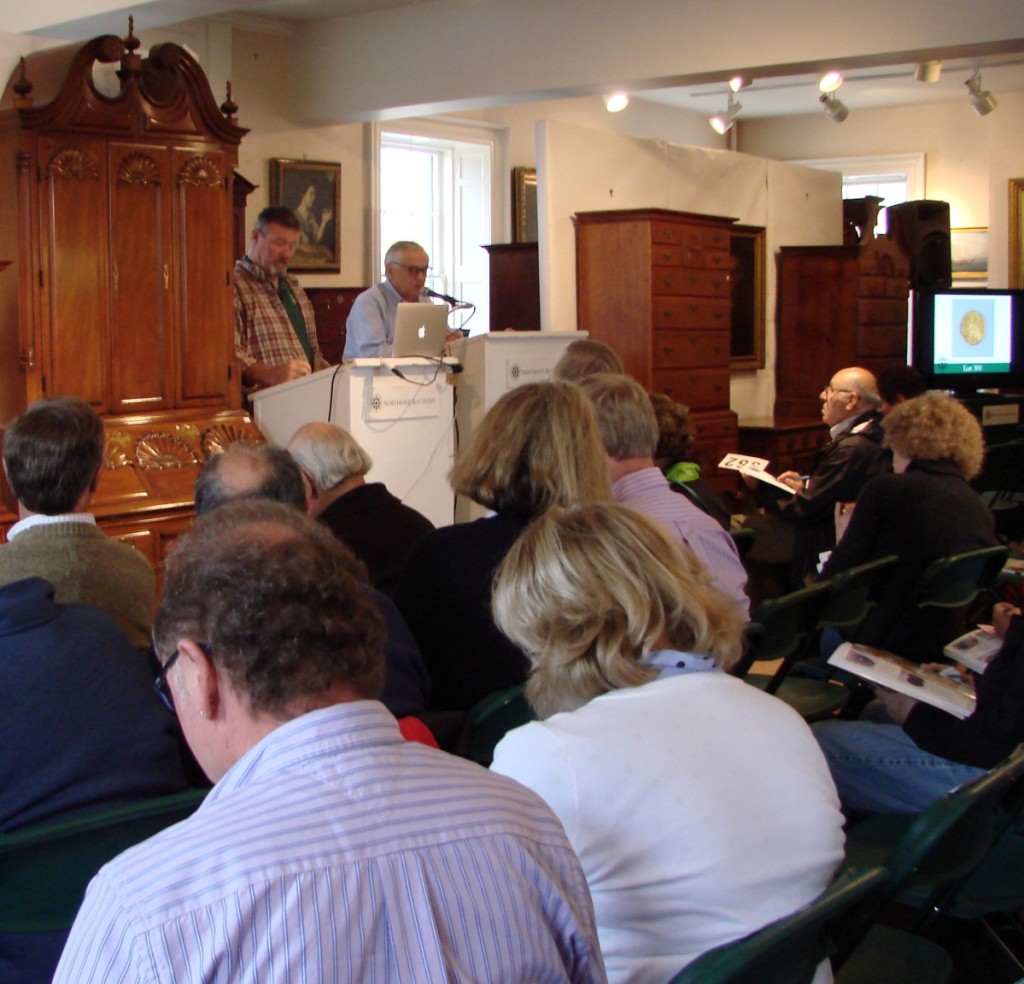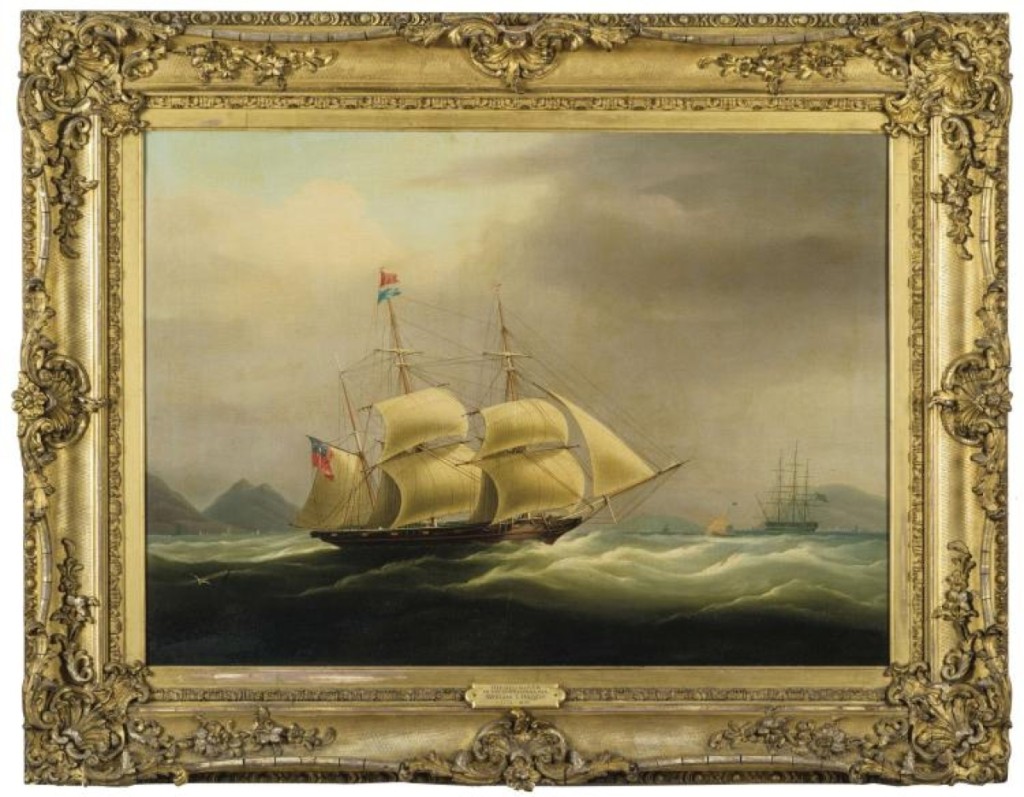
The highest price of the marine paintings was earned by a painting of the famous clipper ship Red Rover in the South China Sea, painted by William J. Huggins. It finished at $44,400.
Review and Onsite Photos by Rick Russack, Additional Photos Courtesy Northeast Auctions
PORTSMOUTH, N.H. – Ron Bourgeault’s fall weekend sale, October 28-29, grossed more than $1,370,000. “I was very, very pleased with the way the sale went,” said the auctioneer. “Buyers knew what they wanted and didn’t hesitate to pay to get the great stuff. And there were enough buyers competing that if something was going inexpensively, they jumped in.
“I’m being very conservative on pricing these days and sometimes that’s difficult to get consignors to understand,” Bourgeault continued. “One consignor was looking at prices for things similar to what he had on fancy retail internet sites, and we had to discuss the difference between real auction prices and how some people price things on the internet. And then some of the things from that person sold to retail European buyers, so it worked out well. It was nice to see some of the Chinese porcelains being bought by Chinese Americans buying back their heritage. And we have to understand some of the ways today’s technology can negatively affect sale results. One client who planned to bid by cell phone on certain things was in a dead zone when those items came up. You have an unhappy buyer and a consignor who might have wound up with less than he would have in ‘the old days’ when everyone was in the room.”
Most of the folk art was sold the first day, and the first lot set the tone. It was a circa 1820 outdoor scene at a Southern picnic, depicting a young family with an older negro slave in a wooded landscape. Its provenance included the Garbisch collection and American folk art collector Ralph Esmerian, and it sold for $18,600, well over the estimate. A pair of profile miniatures by Rufus Porter (1792-1884), depicting Mr and Mrs T.W. Churchill of Elmira, N.Y., went for $5,520, also well over the estimate. A profile watercolor miniature by Ezra Wood, aka “The Puffy Sleeve artist,” also did well, finishing at $4,080. The highlight of the folk art, however, and one of the highest prices of the sale was achieved by a wonderful, brightly colored oil depicting the “G.D. Braisted Palace and Oyster Ground.” Garrett Dorsey Braisted went into the oyster business in the 1850s and built his establishment, probably on the east bank of the Hudson River, in upper Manhattan. The scene included the river with several boats, the mansion and the signage identifying the establishment. At one time, the lower Hudson had more than 350 miles of oyster beds, and it was said to contain “half the world’s oysters,” giving rise to New York being called “The Big Oyster.” Or so the story goes. Be that as it may, the painting realized $49,200.
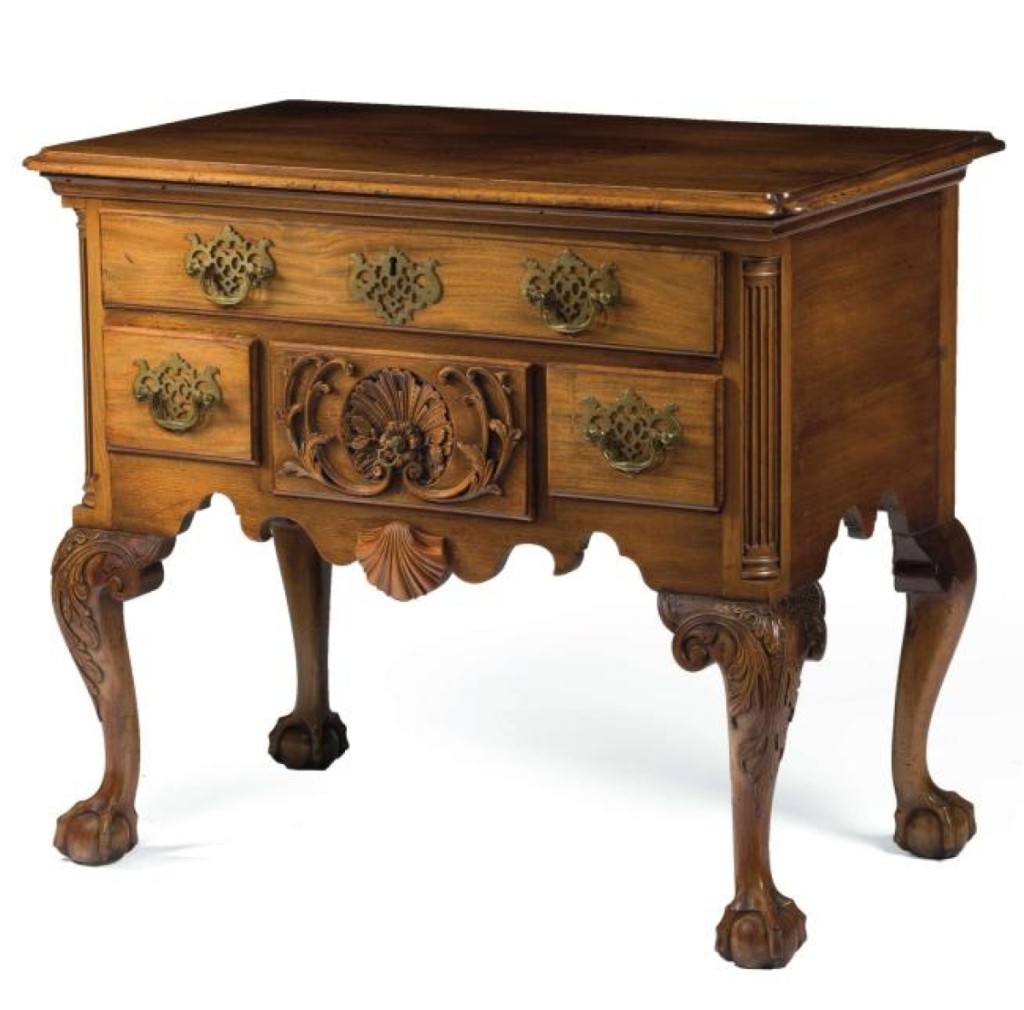
Bringing about five times the estimate, this Philadelphia carved walnut dressing table sold for $51,600. The central drawer had elaborate shell and scroll carving, and there was acanthus carving on the cabriole legs. It was one of the highest priced items.
The first day also included books and prints. A full set of engravings of “The City of Philadelphia in 1800” by William Russell Birch (1755-1834) achieved $55,200. Each was hand colored and framed, and the lot included four additional pages with the map. The first octavo edition of Audubon’s The Birds of America in seven volumes containing 500 hand colored lithographic plates, published between 1840 and 1844, earned $33,600. Two engravings from “The Seven Deadly Sins” after Pieter Brueghel, done by Pieter van der Heyden, published in Antwerp in 1558, sold for $5,280 and $5,760. Also sold on the first day were several lots of canary yellowware from the Tananbaum collection, being sold to benefit Winterthur, and a selection of historical blue Staffordshire. A scarce pitcher and bowl set, depicting the “Landing of Gen LaFayette at Castle Garden NY in 1824” topped the historical blue category, finishing at $3,480. Two engine-turned pieces of yellowware led that category, finishing at $720. One piece was a milk jug, turned in a grid pattern, with alternating solid blocks and alternating reeded squares, and the other was a small jug. A Wedgwood three-color jasper, engine-turned coffee can and saucer, circa 1785-95, went out over estimate at $1,140.
The second day began with a group of Georgian silver from an American collection. A George II armorial tray, 17½ inches wide, made by Robert Abercromby, London, 1735-36, topped the collection, bringing $5,520. A pair of George II cast silver crested candlesticks by William Gould, London, 1750, went for the same price.
Northeast usually does well with high-quality reproduction furniture, and this time results were mixed. A handsome Newport-style secretary bookcase from the Vincent Price National Treasures Collection brought just $1,200, while a set of ten bench-made Boston Chippendale chairs, including two armchairs, sold for $2,040, and a set of six custom made, reproduction bow back Windsors made by Stephen Bedard, Gilmanton, N.H., reached $3,240.
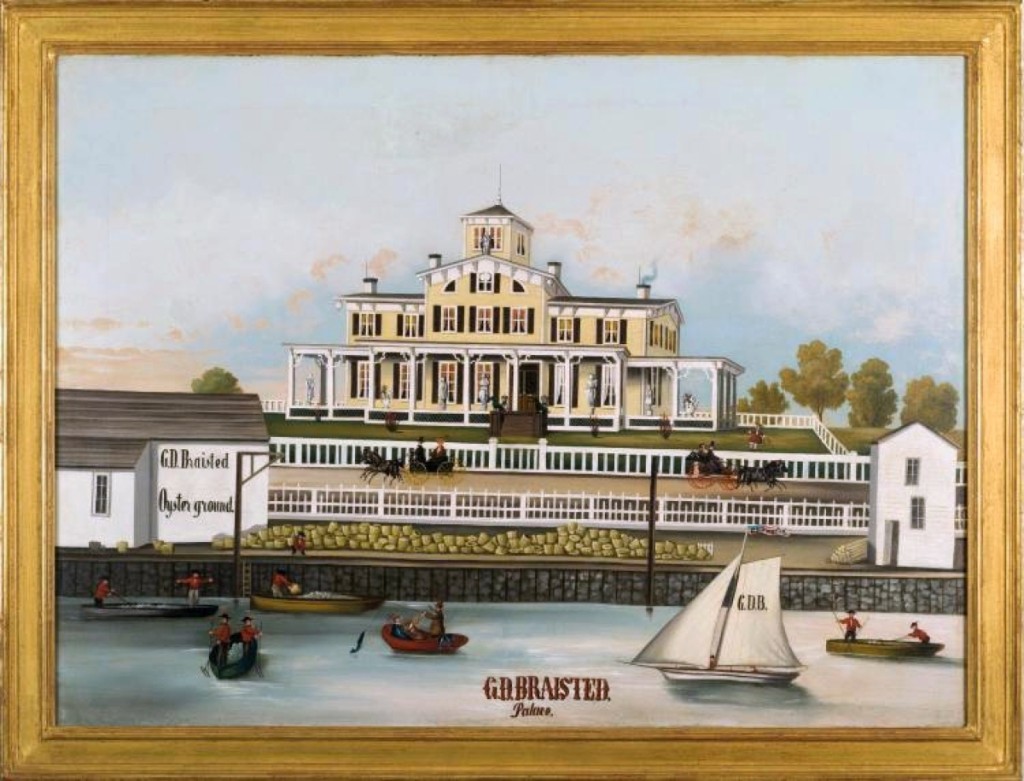
One of the highest prices of the sale, $49,200, was achieved by a brightly colored mid-Nineteenth Century oil depicting the “G.D. Braisted Palace and Oyster Ground.” The site was probably on the east bank of the Hudson river in upper Manhattan.
Buyers were selective with period American furniture. Some did well and there were certainly bargains to be had. Competition was strong for a Philadelphia carved walnut dressing table that sold for $51,600, more than five times the estimate. It had notched corners and one long drawer over three. The central drawer had elaborate shell and scroll carving, and the cabriole legs were acanthus carved, ending in ball and claw feet. It was one of the highest priced items in the sale. Also popular with bidders was a New York Chippendale slant lid desk with the label of Samuel Prince, together with a bookcase top. The bookcase top, probably added 20 years later, had a pitched pediment crest centering a Philadelphia rococo cartouche. It reached $12,600. Prince was a Revolutionary War period cabinetmaker in New York whose work is at both Winterthur and the New-York Historical Society. A circa 1800 Aaron Willard tall case clock also did well, bringing $26,400. In the bargain category was a circa 1810 New Hampshire birch tall chest of drawers with a red wash that brought only $1,200. Also reasonably priced was a Newport Chippendale serpentine front slant-lid desk that went out for $5,040.
One of the surprise strong sellers of the day was a red and white double woven coverlet, dated 1841, James Cunningham, New Hartford, N.Y. It displayed a spread-wing American eagle over the words “Under This We Prosper,” George Washington mounted on a horse and the words, “United We Stand, Divided We Fall.” Estimated at $500, it achieved $3,840.
Paintings, especially marine works, were a strong segment of the sale. Several were from a Maine coastal estate. Leading the group, finishing at $44,400 was a painting of the clipper ship Red Rover in the South China Sea, painted by William J. Huggins (British, 1771-1845). Inscribed on the reverse was “Red Rover/belonged to Alexander Robertson” in whose family it remained until being sold by Sotheby’s London, in 1986. The Red Rover was known for making the fastest round trips between Canton and Calcutta. The second highest price of the marine paintings was achieved by a circa 1850 portrait of the American packet ship Excelsior arriving at Liverpool at sunset. Done by Duncan McFarlane (British, circa 1818-1865), the painting sold for $31,200, well over the estimate.
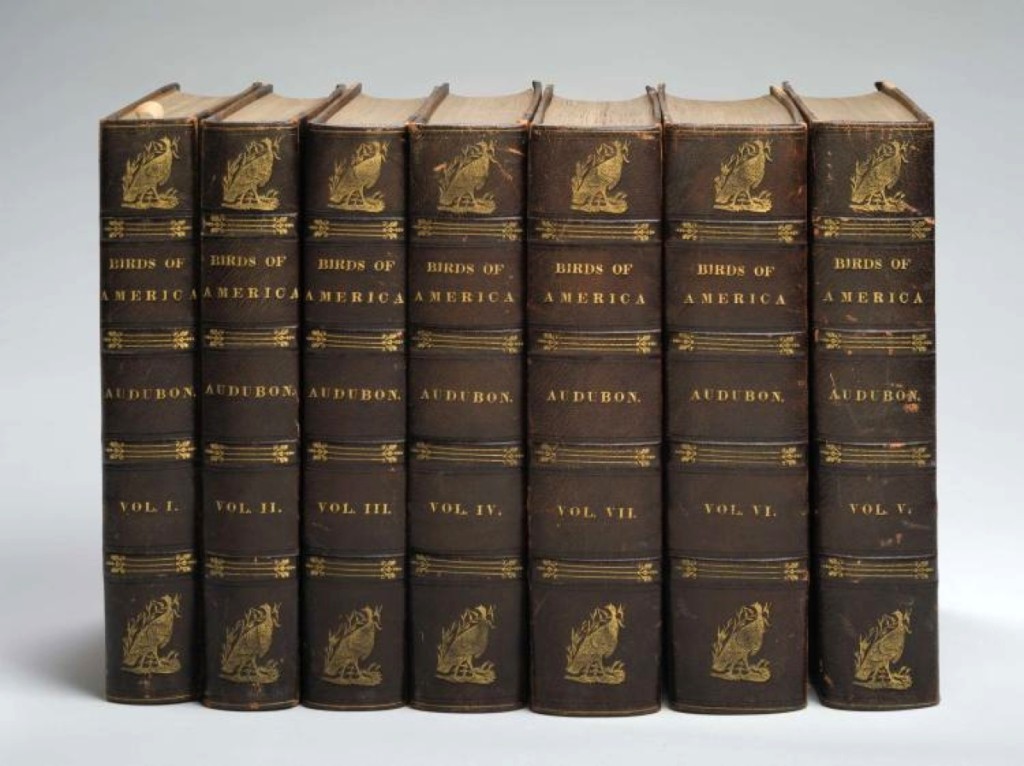
The first octavo edition of Audubon’s The Birds of America in seven leather-bound volumes, containing 500 hand colored lithographic plates, published between 1840 and 1844, realized $33,600.
A view of the American ship Star off Point Lynas inbound for Liverpool, painted by Samuel Walters, (British, 1811-1882), earned $22,200. A portrait of the American schooner Maria Hall of Boston, entering the port of Baltimore, fetched $7,500. It had been painted by William Hare (American, 1815-1865). An unsigned work by Thomas Chambers (American, 1808-1869) depicting the Baltimore schooner Chesapeake passing Brodkin Lighthouse went for $15,000. A view of Greenock Scotland by Robert Salmon (Anglo American, 1775-circa 1848) earned $18,000.
A large China Trade painting of Hong Kong Harbor, circa 1850, depicted American, French, Danish and Chinese shipping in the harbor. It was the most sought-after of the China Trade works, finishing at $20,400. Also popular with bidders, bringing more than twice its estimate, was another Hong Kong Harbor scene, this one depicting a three-masted sailing ship flying an American flag. The final price was $11,040.
Rounding out the sale was a group of Chinese export porcelain, including several early pieces, dating to the mid-Seventeenth Century, from the wreck of the VOC (the Dutch East India Company) ship Geldermalsen, salvaged by Michael Hatcher and sold at Christie’s in Amsterdam in 1986. Of particular interest to bidders was a group of ten such pieces, which sold for $2,520, more than twice the estimate. Bringing the highest price of Chinese export material was a rare circa 1740 “Cape of Good Hope” 9-inch plate, made for the Dutch market, painted in famille rose enamels, with a view of Dutch ships at anchor in Table Bay, Cape Town, South Africa, with Table Mountain visible in the distance. It realized $8,640.
As Bourgeault said, it was a strong sale, with multiple bidders willing to pay what they had to for choice material.
Prices reported include the buyer’s premium. For more information, 603-433-8400 or www.northeastauctions.com.

